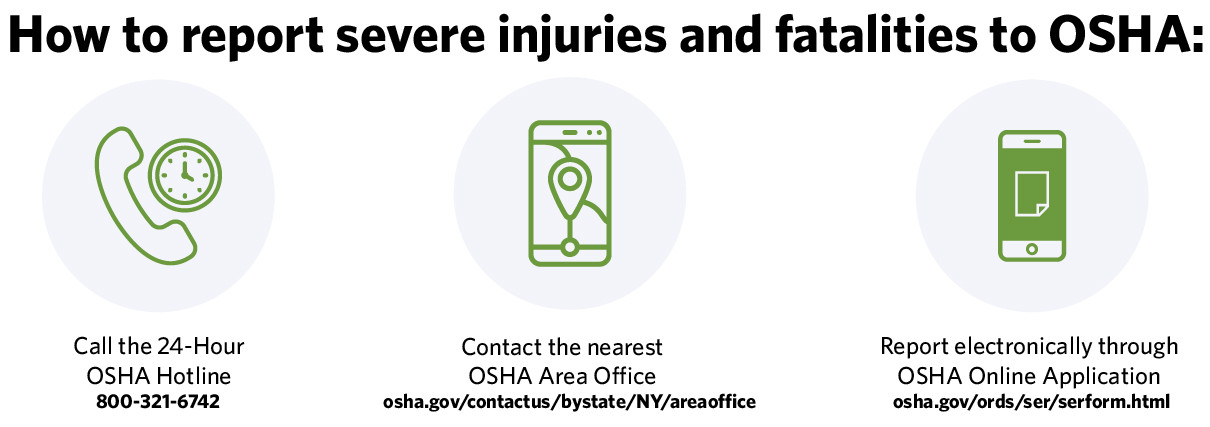OSHA Compliance

OSHA Rules and Regulations For Farms
Who is Subject to OSHA Rules and Regulations?
Farms that have had more than 10 total employees, not including immediate family members, at any time in the past 12 months preceding the day an inspector shows up (1 part-time employee is equal to 1 full-time employee). OSHA can inspect certain businesses based on four priorities:
- Imminent danger
- Catastrophes and fatal accidents
- Complaints and referrals
- Programmed inspections
What Records do I need to Keep?
- The U.S. Department of Labor has recently announced that some large employers will now need to submit their injury and illness information to OSHA electronically. This change applies to designated high-hazard industries, including agriculture, and takes effect on January 1, 2024. The rule now includes the following submission requirements: Agricultural establishments with 100 or more employees must electronically submit their OSHA 300 and 301 forms between January 2 and March 2 of 2024 and by March 2 every year hereafter. This information about each recordable injury and illness during the previous calendar year includes the date, physical location, and severity of the injury or illness, details about the worker who was injured, and details about how the injury or illness occurred. Visit this fact sheet for more information: Improve Tracking of Workplace Injuries and Illnesses (osha.gov)
- Establishments with 20 to 249 employees still need to submit the 300A-Summary of Work-Related Injuries and Illnesses for the previous year electronically by March 2 each year. If you had less than 20 employees at an establishment, keep the Injury and Illness Reporting logs on file. The Injury and Illness Reporting Logs should be kept on file for five years. Information on this can be found at: https://www.osha.gov/recordkeeping/index.html[MAE1]
- By February 1, physically post your OSHA 300A Summary of Work-Related Injuries and Illnesses for 2023 in a conspicuous location. Farms with 11 or more full or part-time workers are required to maintain and post a hard copy of their OSHA 300A from February 1 until April 30 each year at each establishment.
What Are The Injury Reporting Requirements?
OSHA Requirements for reporting a fatality or severe injury:
- All employers of any size are required to notify OSHA when an employee is killed on the job or suffers a work-related hospitalization, amputation, or loss of an eye.
- A fatality has to be reported within 8 hours.
- An in-patient hospitalization, amputation, or the loss of an eye must be reported within 24 hours.
For more information on this regulation, visit https://www.osha.gov/report.html and see the infographic below for reporting methods:

How can NYCAMH Assist You?
Free On-farm Safety Surveys can help you prepare. Surveys combine farm hazard identification and discussion to help owners/managers understand what might be hazardous and why and strategies to mitigate problems. A farm owner/manager must participate in the session, which can take anywhere from a half hour to over eight hours, depending on the size of the operation. They discuss recommended safety improvements and specific training topics relevant to the workers. The farm receives a written report outlining the OFSS findings within 30 days. If applicable, the educator may refer the farm to other NYCAMH services, such as the NYCAMH John May Farm Safety Fund, which facilitates safety improvements for small and midsize farms in NY. This program provides grants covering 50% of the cost of a safety project up to a maximum of $5000.
NYCAMH Resources
- Farm Safety Check Lists
- Safety Policy Templates
- Bi-lingual (English and Spanish) Safety Training Rosters
- Farm Partners
- Farm Fit Testing Program
- NYCAMH YouTube Channel
Useful Links
- Occupational Safety & Health Administration (OSHA)
- OSHA: Agricultural Operations
- OSHA: Hazard Communication
- OSHA: Compliance Assistance Quickstart
- OSHA: Small Business Owners Handbook
- OSHA: Field Operations Manual (FOM)
- OSHA: Medical and First Aid
New York State Resources
- New York State Department of Labor On-Site Consultation Service
- New York State Occupational Health Clinic Network
Trusted Partner Resources
- Agricultural Tailgate Training Safety Modules from Ohio State University
- Maine Farm Safety Program Training Fact Sheets
- AgriSafe Network Safety Training Webinars
- National Ag Safety Database
- Farm Safety Resources from Penn State University
- eXtension Ag Safety and Health Resources
- U.S. Ag Center's YouTube Channel
